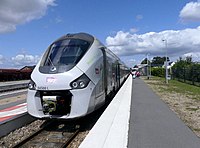
Photo from wikipedia
Employment of edible oils as alternative green fuel for vehicles had raised debates on the sustainability of food supply especially in the third-world countries. The non-edible oil obtained from the… Click to show full abstract
Employment of edible oils as alternative green fuel for vehicles had raised debates on the sustainability of food supply especially in the third-world countries. The non-edible oil obtained from the abundantly available rubber seeds could mitigate this issue and at the same time reduce the environmental impact. Therefore, this paper investigates the catalytic cracking reaction of a model compound named linoleic acid that is enormously present in the rubber seed oil. Batch-scale experiments were conducted using 8.8 mL Inconel batch reactor having a cyclic horizontal swing span of 2 cm with a frequency of 60 cycles per minute at 450 °C under atmospheric condition for 90 min. The performance of HZSM-5, HBeta, HFerrierite, HMordenite and HY catalysts was tested for their efficiency in favouring gasoline range hydrocarbons. The compounds present in the organic liquid product were then analysed using GC-MS and classified based on PIONA which stands for paraffin, isoparaffin, olefin, naphthenes and aromatics respectively. The results obtained show that HZSM-5 catalyst favoured gasoline range hydrocarbons that were rich in aromatics compounds and promoted the production of desired isoparaffin. It also gave a higher cracking activity; however, large gaseous as by-products were produced at the same time.
Journal Title: Environmental Science and Pollution Research
Year Published: 2018
Link to full text (if available)
Share on Social Media: Sign Up to like & get
recommendations!